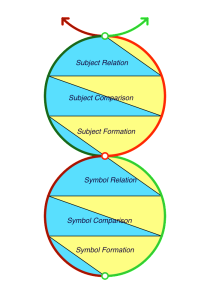Formation, Comparison and Relation
The double-helix model defines four realms of consciousness and four corresponding spheres of self-consciousness. This gives us eight domains to cover.
The powers of understanding in each way of knowing are themselves developed as they are explored within the domain. In this way, each domain has an inherent structure. The inherent structure has common features as follows: first, a new idea is formed (formation); next, the idea is compared with other ideas (comparison); finally, the ideas are related in a coherent way according to the powers of the way of knowing. This structure applies to both knowing the world and knowing the self. For some analogies of how formation/comparison/relation work, click here.

Formation, comparison and relation in the Symbolical Realm, showing the advent of language (symbol formation) and its internalization (subject formation).
Here is an example of this from the period of development of young children from the time they start to acquire language to when they internalize language (approx. 18 months to 3 years). One word speech is the formation of a symbolic idea; two-word sentences help clarify one symbolic idea from another; declarative sentences cover the noun-verb-object relations of simple syntax.
With three steps for each of eight domains, the double-helix model comprises a total of 24 steps. There are two ways in which not everyone experiences these steps: 1) a person doesn’t attain a higher level of understanding (this will be clarified further in the debate over “formal” versus “post-formal” operations), and 2) a person is particularly intuitive within a domain and effectively skims right over the steps to the next level of understanding. In the second instance, we can say that the steps are still there but that this person doesn’t need to linger on them, but understands the domain more holistically.